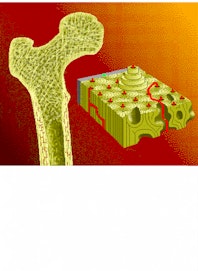Periosteum

Periosteum is the thin yet tough outermost layer of bones. Its many collagen fibers support the bone and firmly connect it to the surrounding structures. Osteogenic cells in the periosteum play a vital role in the growth and repair of bony tissue. In many ways, periosteum acts like the skin of the bones.
Anatomy
Periosteum is an extremely thin region of non-calcified tissue on the exterior of bones. It covers the entire surface of every bone in the body, with the exception of the joint-forming ends of bones where cartilage forms the bone's outer layer.
Periosteum consists of an outer fibrous connective tissue layer and an inner osteogenic layer. The fibrous layer is made of dense irregular connective tissue containing many strong collagen fibers and fibroblast cells. Fibroblasts produce the collagen fibers and regenerate the fibrous layer as it wears down over time or is injured by stress to the body. The osteogenic layer contains many stem cells and osteoblast cells lining the surface of the osseous tissue that makes up the hard part of the bone. Osteoblasts absorb calcium to form the mineral matrix of solid bone.
Physiology
The fibrous layer of the periosteum plays a vital role in connecting bones to the rest of the body. The collagen fibers of the periosteum not only wrap the entire bone, but also merge with the collagen fibers of the ligaments, joint capsules, and tendons that connect to the bone. Thus, a continuous mass of collagen runs from each bone's surface, across joints through ligaments and joint capsule to the neighboring bones. Likewise, collagen extends from the periosteum into tendons; extends around and through muscles as the muscular fascia; recollects as another tendon; and inserts on another bone.
Periosteum also plays an important role in bone growth and maintenance. Throughout life, bones are constantly being remodeled to adjust their size and thickness to the demands of the body and the availability of calcium to form bone. As bones grow larger, most of this growth is produced by osteoblast cells in the periosteum, which absorb calcium ions from the blood and produce hard mineral matrix. When bones fracture or are damaged microscopically by stress, the osteoblasts of the periosteum repair this damage and replace the mineral matrix, often reinforcing the bone beyond its original thickness.


